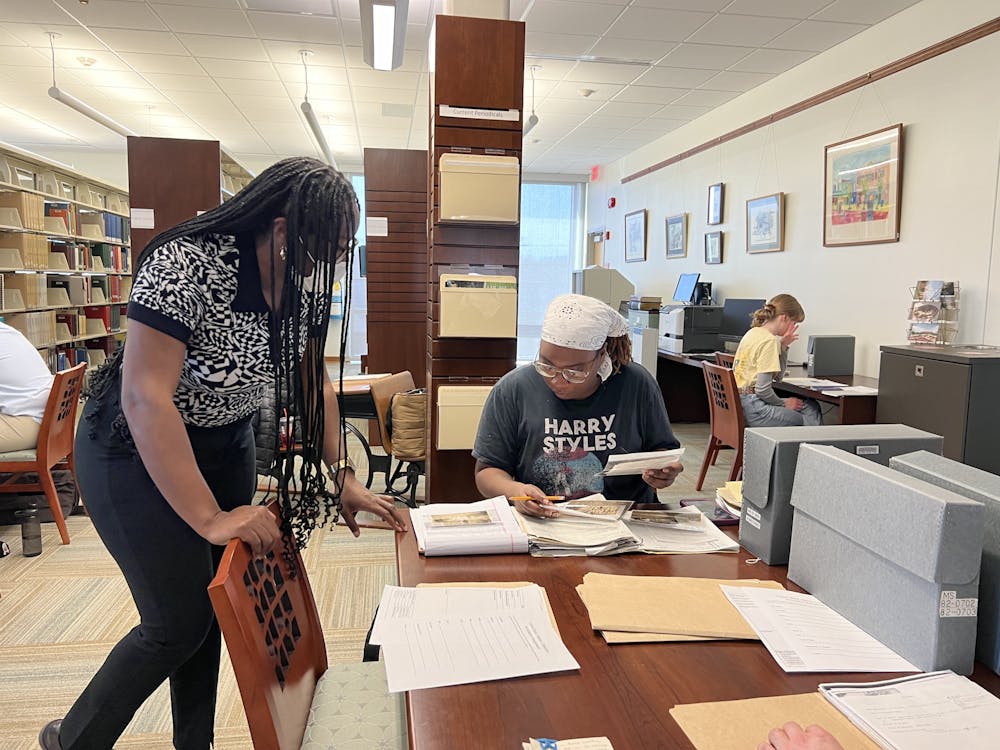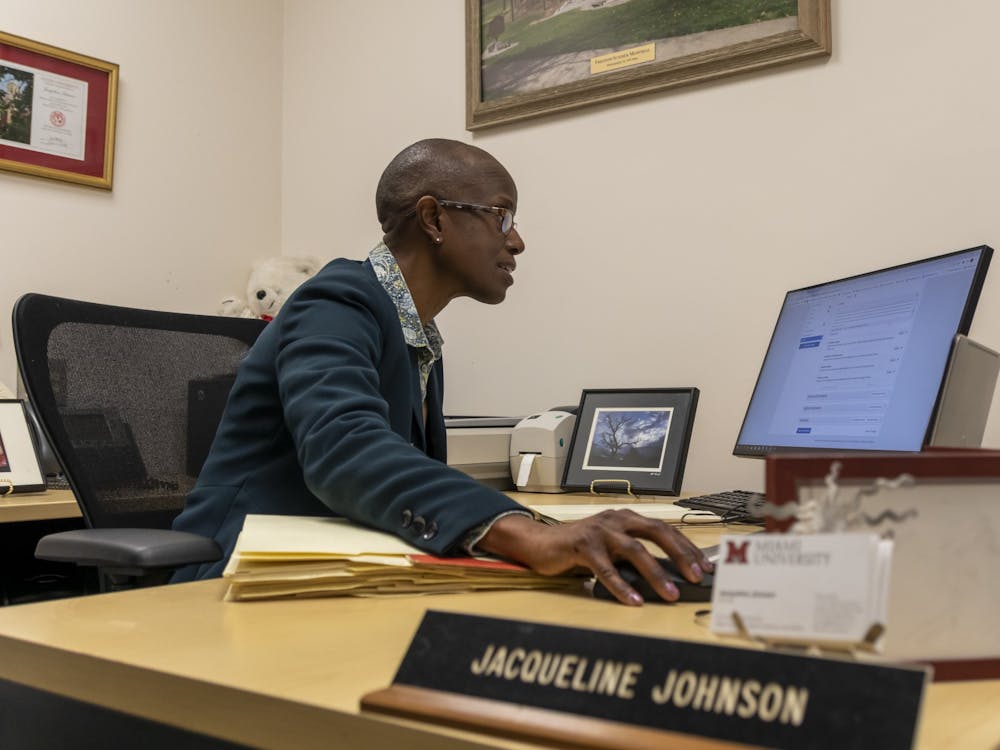
(Amber Siebenaler)
Nine thousand miles and one military cargo plane away, there is more than just ice and penguins in the polar desert of Antarctica. Miami University has been leaving its mark there for five years now.
After a choppy helicopter ride through the vast Transantarctic Mountains, Miami Associate Microbiology Professor Rachael Morgan-Kiss drills into a frozen lake within an arctic valley. Her goal: to study the microorganisms she finds and learn how they live in the harshest environment in the world.
Needless to say, her office hours vary.
"It's the ultimate 'high' adventure," she said with a smile.
After growing up in a small town on Vancouver Island in Western Canada, Morgan-Kiss enrolled in the University of Victoria on the same island for her undergraduate studies. She received her Bachelors of Science working primarily in plant biology research, but quickly took a U-turn in graduate school.
"I went to the University of Western Ontario to work with Dr. Norman Huner to study crops that handle cold better than others," Morgan-Kiss said. "But he wanted a student who would study plants in permanent cold environments."
So she worked with Huner and studied such plants. Once Morgan-Kiss finished her Ph.D. project on Antarctica algae, she was hooked on the cold.
After working on various projects in many places across the United States, Morgan-Kiss ended up at Miami and she has been organizing annual trips to Antarctica for the past five years.
"We have gone [to Antarctica] three previous times, took a year off, and are going for a final time in October," she said.
Morgan-Kiss typically travels with a team of four graduate students, but has taken undergradsuates who could work the trip into their schedule. At about $100,000 per person, though, this is not your typical abroad trip.
Enjoy what you're reading?
Signup for our newsletter
"We travel through the U.S. Antarctic Program, which is the only program that funds people going there," Morgan-Kiss said. "Each trip takes five or six years to plan."
Each venture to the outermost reaches of the world begins with a commercial flight to New Zealand. From there, the team piles into a military cargo plane that takes them to a U.S. outpost called McMurdo Station on the coast of Antarctica. Their final leg shoots them through the mountains by helicopter to camps within Antarctic valleys.
At the camps where the team stays, Morgan-Kiss and the students spend each day on frozen lakes taking samples and studying the organisms that can survive in such cold surroundings, while simultaneously determining how climate change will affect these organisms.
Morgan-Kiss' main research focus is on organisms called eukaryotes, which are the ancestors of all animals.
The students may be working on separate projects from what Morgan-Kiss is doing, so when the trip ends, they bring the samples they get from the lakes back to Miami to work with throughout the rest of the year.
Graduate Student Nick Ketchum traveled to Antarctica with Morgan-Kiss in 2009, and loved it so much he went back in 2010. He did not know he would be traveling to Antarctica when he first started his work with Morgan-Kiss, but when the opportunity presented itself, he jumped on it.
"I really got close with her and we immediately worked very well together," Ketchum said. "She got the grant to go to Antarctica and I was one of the first students to go on the trip."
In the field, Ketchum collected samples to bring home for a graduate project. What he recalls most about the fieldwork is how stunningly quiet it was.
"It feels like an alien planet, like you're on Mars," he recalled. "The only noise is you."
But experiencing this feeling does not come easy.
Before beginning their work, Ketchum and his team needed to undergo safety emergency training, which included learning how to build igloos and snow trenches if a situation required it. Such training proved life-saving when the team found itself up against Type 3 weather: less than negative 20 degrees Fahrenheit temperatures, whiteout conditions and extreme wind.
"It was a negative 60 degree whiteout," Ketchum said. "Whenever I closed my eyes, my eyelashes froze shut. I would need to thaw them with my fingers."
To endure such weather, the team is equipped with extreme cold weather (ECW) clothes, which includes extra heavy jackets and multiple layers. The team definitely needs these clothes, because it can get very cold in the tents on the ground that they sleep in.
But when the weather behaves more, Morgan-Kiss likes to Skype her two Microbiology classes that she teaches each semester at Miami via the "field cam." It can be difficult to get a good enough connection to make the call but she loves to connect with her students back home and show them what she is doing.
"When you're a teacher at Miami you have multiple activities and responsibilities that split your time," Morgan-Kiss said. "But in Antarctica it's just you and science. You feel like you're the only person to ever be there."
Alongside the science, though, are Antarctica's natural dangers. Before each trip, the team receives special safety training to help strengthen the buddy system and prevent injuries.
Other than that, Morgan-Kiss said the only other down side to the trip is the isolation from family, or anyone else for that matter.
"You need a really tolerant spouse," she joked.
But she is right, especially since these Antarctic trips last about two months.
It makes sense then that one of Morgan-Kiss' most memorable experiences from the trips is Thanksgiving in Antarctica. Each Thanksgiving, she and her team take a rare day-off to hike around a glacier and across another lake to meet with scientists of a separate camp for dinner.
"It's a time when everyone is missing their loved ones so much, so we definitely try to do that every year," Morgan-Kiss said.
Like Morgan-Kiss and her Thanksgiving experience, each trip member brings home memories that will last a lifetime.
Graduate Student Jenna Dolhi, who traveled to Antarctica in 2011 and 2012, collected Antarctic water samples to study back home.
"Not only does [the trip] open doors for me, but we are doing hard and important work," Dolhi said. "If I can go work in Antarctica, I can do anything."
Though she was happy to return home to eat better food, Dolhi said she could have stayed on what she called "a getaway" forever.
"It's the final frontier, and it's so beautiful," she said while reminiscing about her journey to the top of an Antarctic mountain.
From hiking atop mountains in the most isolated part of the world to hearing nothing but sounds that are your own to laughing at dinner with dozens of the best scientists in the world, the Miami Antarctic teams led by Rachael Morgan-Kiss have gone places and done things most people will never do. The only question is, what's next?
For now, Morgan-Kiss is counting down the days until she can take the Southern plunge one more time.
"I've never liked the heat too much anyways," she said.

(Amber Siebenaler)

(Amber Siebenaler)




